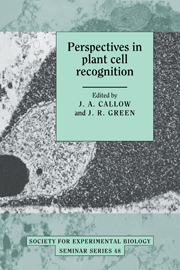Book contents
- Frontmatter
- Contents
- List of contributors
- Preface
- Sexual signalling in Chlamydomonas
- Gamete recognition and fertilisation in the fucoid algae
- The fungal surface and its role in sexual interactions
- Gamete recognition in angiosperms: model and strategy for analysis
- The molecular biology of self-incompatible responses
- Cell surface arabinogalactan proteins, arabinogalactans and plant development
- Local and systemic signalling during a plant defence response
- Contact sensing during infection by fungal pathogens
- The electrophysiology of root–zoospore interactions
- Molecular differentiation and development of the host–parasite interface in powdery mildew of pea
- Recognition signals and initiation of host responses controlling basic incompatibility between fungi and plants
- Cell surface interactions in endomycorrhizal symbiosis
- Host recognition in the Rhizobium leguminosarum–pea symbiosis
- The Rhizobium trap: root hair curling in root–nodule symbiosis
- Structure and function of Rhizobium lipopolysaccharide in relation to legume nodule development
- Index
- Plate section
Cell surface arabinogalactan proteins, arabinogalactans and plant development
Published online by Cambridge University Press: 07 May 2010
- Frontmatter
- Contents
- List of contributors
- Preface
- Sexual signalling in Chlamydomonas
- Gamete recognition and fertilisation in the fucoid algae
- The fungal surface and its role in sexual interactions
- Gamete recognition in angiosperms: model and strategy for analysis
- The molecular biology of self-incompatible responses
- Cell surface arabinogalactan proteins, arabinogalactans and plant development
- Local and systemic signalling during a plant defence response
- Contact sensing during infection by fungal pathogens
- The electrophysiology of root–zoospore interactions
- Molecular differentiation and development of the host–parasite interface in powdery mildew of pea
- Recognition signals and initiation of host responses controlling basic incompatibility between fungi and plants
- Cell surface interactions in endomycorrhizal symbiosis
- Host recognition in the Rhizobium leguminosarum–pea symbiosis
- The Rhizobium trap: root hair curling in root–nodule symbiosis
- Structure and function of Rhizobium lipopolysaccharide in relation to legume nodule development
- Index
- Plate section
Summary
The plant cell surface and plant development
In normal development in multicellular plants, the directions of cell division and of cell enlargement play essential roles in the form assumed by a plant and its organs. Tissue development requires that cellular controls such as division and enlargement act locally. Some tissues (such as the vascular tissues of roots and shoots) display radial symmetry, while others (such as the component tissues of angiosperm ovules) are symmetrical only about a longitudinal axis. However, the structural basis of pattern control and of cell determination cannot be explained purely in terms of the direction of division and of the composition of cell walls (affecting enlargement). Patterning requires that certain cells or cell aggregates close to apical meristems become determined to particular developmental fates, and then differentiate accordingly. The position of these cells in the plant body must be controlled carefully, since all of organogenesis depends upon their differentiation. Somehow, cells acquire positional information early on.
Analysis of the control of plant cell fate is an intractible experimental problem. Genes have been identified that are involved with the control of complex developmental processes such as flowering (Coen et al., 1991), but these appear to affect floral organ identity. Other genes encode structural proteins and glycoproteins in plant cell walls that are developmentally regulated and hence candidates for intercellular interactions (Hong et al., 1989; Keller et al., 1989; Ye & Varner, 1991), but these seem to affect the mechanical properties of the cells rather than control their fate.
- Type
- Chapter
- Information
- Perspectives in Plant Cell Recognition , pp. 105 - 122Publisher: Cambridge University PressPrint publication year: 1992
- 16
- Cited by

